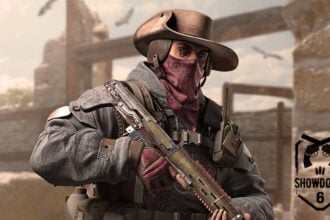In this article, we’ll explain everything there is to know about VALORANT rank and how the system works.
Riot Games entered the FPS genre with the launch of VALORANT. It is a 5v5 tactical shooter where Agents’ abilities meet the precise gunplay. The game is heavily inspired by CS: GO’s FPS mechanics and Overwatch’s hero-shooter aspects.
Although most people were initially skeptical about VALORANT’s success, their impression changed when VALORANT started to gain popularity. More than 20 million average players play VALORANT each month.
VALORANT has different game modes, including Deathmatch, Spike Rush, Unrated, and Competitive. Additionally, there are three more rotating game modes called Escalation, Replication, and Snowball Fight, which change with every patch. Of all these game modes, Competitive or Ranked is the most popular playlist in VALORANT.
Read More: VCT 2023 Global Contract Database: Full Roster, Players, Coaches, & More
What is VALORANT Rank?
As mentioned earlier, there’s a Competitive game mode in VALORANT. This game mode is also referred to as Ranked. Players are given specific ranks based on skills, MMR, and Rank Ratings in this Competitive game mode.
The point of having a Competitive or Ranked mode is to play against similarly skilled opponents so you can enjoy the thrilling and nail-biting experience of VALORANT matchmaking. If you are new to this game, you must play a certain amount of Unrated matches to unlock Competitive mode and get a specific rank.
All VALORANT Ranks
There are 9 rank tiers in VALORANT. Each of these ranks has three sub-tiers, except for Radiant. Radiant accounts are a special rank category representing the best of the bests. Only the top 500 from each Region can reach Radiants.

Previously, there were 22 ranks in VALORANT. However, Riot Games recently added a new rank tier called Ascendant starting from Episode 5 Act 1. So, with the addition of Ascendant, there are currently a total of 25 ranks in VALORANT.
Here’s a list of all ranks in VALORANT:
- Iron 1
- Iron 2
- Iron 3
- Bronze 1
- Bronze 2
- Bronze 3
- Silver 1
- Silver 2
- Silver 3
- Gold 1
- Gold 2
- Gold 3
- Platinum 1
- Platinum 2
- Platinum 3
- Diamond 1
- Diamond 2
- Diamond 3
- Ascendant 1
- Ascendant 2
- Ascendant 3
- Immortal 1
- Immortal 2
- Immortal 3
- Radiant
How to Unlock Competitive Mode or Ranked?

Starting from Episode 4 Act 1, players need to have at least 20 levels before they can unlock Competitive or Ranked. However, if you played Ranked before Episode 4 Act 1, and your level is below 20, you’ll still be able to unlock Ranked.
Prior to Episode 4, new players needed to play at least 10 Unrated matches before unlocking Competitive Mode. However, the new rule requires new players to play only 5 Unranked (placement) matches before they are given a certain rank.
Additionally, every player’s rank resets every Episode and Act. To get their ranks back, everyone needs to play 5 Ranked matches after a new Episode and 1 Ranked game after Acts 2 and 3. A player can get a maximum Ascendant 1 after placement matches or buy a boost.
What are Act and Episode?

According to VALORANT Wiki, “Episodes are the biggest competitive time frames in VALORANT. They contain 3 Acts, meaning that one episode is about 6 months long.”
Riot Games releases a new Act about every 2 months and a new Episode after every 6 months. But does it have anything to do with ranks? Yes, there’s a connection because your rank gets reset every Act.
So, you need to play some placement matches to get your rank back. For a new Episode, you must play 5 placement matches, and for Act 2 and 3, you must play 1 placement match before you get your rank back.
One more thing to remember, the highest Ranked win will determine your Act rank. For example: if you reach the maximum Diamond 3 rank in an Act and win one match while being in that rank, your Act rank will be Diamond 3. And your overall Rank Rating will determine your rank.
What is RR or Rank Rating?

According to VALORANT’s official description, “Rank Rating (RR) represents a visual way to track your progress as you climb, and works differently for ranks Iron through Ascendant than it does for Immortal and Radiant ranks.”
To simply describe, Rank Rating is a point system that you get for winning matches in VALORANT. Similarly, you lose your Rank Rating for losing a match. Winning and losing have the most significant impact on your RR going up or down, depending on the end of the match.
However, other factors also play a role while contributing to positive or negative RR. How much you win by, extraordinary plays, and whether or not you’re the underdog in a match can all have an effect. Since we’re looking at the individual, it’ll be your performance under review, rather than that of your teammates.
What is MMR or Matchmaking Rating

Matchmaking Rating, or MMR, is also an important factor that affects your RR. It is a giant ladder that includes every player in VALROANT’s ecosystem. Additionally, no two players can hold the same spot on that ladder.
MMR is an accurate representation of your skill set in VALROANT. However, it is a hidden system, and no player can actually see anyone’s MMR. But how does it affect RR?
In general:
- If your MMR is higher than your rank, you’ll gain more RR on wins than you lose on losses.
- If your MMR is even with your rank, you’ll gain and lose closer amounts of RR for wins and losses.
- If your MMR is lower than your rank, you’ll gain less RR on wins and lose more on losses.
You can increase your MMR by outperforming your opponents and winning more consistently. But that doesn’t guarantee you rank up.
How to Rank Up?

In short, you need to win matches to make your way up to the top of the rank. However, there is more than just winning. Your performance in a match also matters. The better you perform, the more Rank Rating (RR) you get.
After you get a rank after the placement match, you’ll start with 50 RR or halfway in that tier. You need 100 total RRs to reach the next rank. So, if you are in Gold 3 and have 50 RP, you need 50 more RP to reach Platinum 1.
After you reach a new rank tier, you’ll start with at least 10 RR, as things might get awry in a new rank. But don’t worry. Even if you lose the next match, you won’t get demoted instantly due to demotion protection.
For example, if you are in plat 1 with 10 RR and lose more than 10 RR after losing a match, your RR will get to 0. After that, if you lose one more match, you’ll get demoted to Gold 3. But remember, this time, your RR will start from 70, and you’ll have to gain 30 RR again to rank up.
Does Party Affect Rank Rating?

In short, Yes! It does. However, there’s more to it.
There are some rules and regulations when it comes to playing with a party or friends in VALORANT. You can play as a solo or as a party of two, three, and five people. If you play as a solo, there is no restriction or Rank Rating penalty for you. However, to play in a party of two, three, and five people, you must maintain some rules and restrictions.
To make things easier for you, we will divide the restrictions into two separate sections: 1. Party Restriction 2. Rank Rating Restriction.
Party Restriction
If you’re playing in a group of 2 or 3 players, you’ll only be able to join a Ranked match with friends within a specific rank range. Check out the breakdown below:
For parties of 2 or 3, players can queue within certain Ranked disparity restrictions:
| Lowest Rank in party | Highest Rank in Party |
|---|---|
| Iron and Bronze | Silver |
| Silver | Gold |
| Gold | Platinum |
| Platinum, Diamond, Ascendant, Immortal, and Radiant | Exactly 1 tier higher max (Example: Platinum 2 can queue with up to Diamond 2) |
There are no restrictions for parties of 5 or 5-Stacks, meaning any rank can queue with any rank. Even a Radiant can queue with an Iron player as long as there are three more players present in the same lobby. So, as long as there are 5 players playing together, anything goes.
Additionally, people with Immortal 1 rank or above can’t play in a group of 3. So, only Solo, Duo, and 5-stack are allowed for Immortal 1 and above.
Rank Rating Restriction
There will be no Rank Rating restriction for Solos, Duos, and Trios. However, as there are no party restrictions for 5-stacks, VALORANT follows an adjusted ruleset given the potential disparity in rank for the players on the team.
- If everyone in your 5-stack group is Ascendant 3 or below, the team will receive a 25% RR reduction if any players are Ranked outside of normal party restriction ranges.
- If one or more members of your 5-stack group are Immortal 1 to Immortal 3, the team will receive a 25% RR reduction penalty.
- If one or more of your 5-stack group are Radiant, the team will receive a 75% RR reduction. Having any players in your group that are below Radiant automatically reduces your potential RR by 90%.
Does VALORANT Have Rank Decay?

No, VALORANT does not have a Rank Decay system. If you don’t play Competitive or Ranked for 14 days, your rank will not appear in your profile. However, that doesn’t mean you lost your rank. Once you play one more Competitive or Ranked again, your rank will re-appear.
But for those of you hanging out in the Immortal and Radiant ranks, you can drop on the leaderboard. Your rank isn’t decaying, however. It just simply means that your position on the leaderboard has shifted.
Read More: Best VALORANT Crosshair & Codes (November 2022)
There you go! Now you know everything about VALORANT rank system, how it works, and how to climb up the rank. So, without wasting any more time, get into the game and enjoy the competitiveness of VALORANT Ranked.









